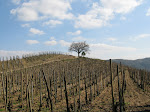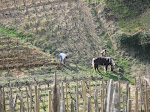Alain Jeanniard comes across as a very thoughtful, unassuming, yet confident man. Those are qualities that many top winemakers seem to possess. While totally unknown in the U.S., Jeanniard has recently begun to receive attention in England. The British critic Steven Spurrier took notice of this new producer at a trade tasting in the spring of 2008. Mr. Spurrier wrote "Alain Jeanniard, a domaine in Morey-Saint-Denis and new to me, showed tight, intellectual wines with a superb Chambolle 1er Cru Les Combottes that rivaled the Clos des Lambrays on the next table for half the price."

Alain Jeanniard
In 2000, Alain Jeanniard left behind a career in industry and returned home to begin putting together a small domaine. Through the renting of vineyards from his family and some shrewd purchases, Alain has formed an estate totaling four hectares. The domaine, whose first vintage was 2004, annually produces less than 2,000 cases from its tiny facility located just down the street from the Domaine des Lambrays. The winemaking is a blend of modern and traditional practices. After being harvested by hand, the grapes are completely de-stemmed. The vinification of the must takes place at 30 degrees Celsius and the juice is then aged in 20% new oak. Batonnage is performed once a month. I visited the domaine on March 20th of this year and tasted several of the 2007 cuvees from barrel. The 2006s had already been bottled.
1- Hautes-Cotes-de-Nuits, blanc, 2006 - (15 year old vines) Very fresh on the nose. The wine has a great texture and is full ripe, tropical fruits. A strong blast of minerals comes through on the finish. This wine reminds me of a really good Meursault. Amazing for this level.
2- Bourgogne, Passe Tout Grain, 2006 - (40 year old vines) This wine is very focused and bright on both the nose and palate. The long finish is dominate by red fruits and lively acidity.
3- Bourgogne, rouge, 2006 - This cuvee is sourced from vineyards in Morey-St.-Denis with yields of 35 hectoliters per hectare. The nose is full of elegant red fruits and the palate shows a beautiful earthiness that screams Morey.
4- Hautes-Cotes-de-Nuits, rouge, 2006 - (15 year old vines) Really nice texture. Rich, dark fruits coate the palate. Excellent.
5- Chambolle-Musigny, VV, 2006 - (80 year old vines) Very nice dark berry fruit on the nose. Meidum-full bodied with a long finish.
6- Gevrey-Chambertin, 2006 - (45 year old vines) Very expressive nose of red fruits. Full-bodied, but elegant on the palate. Beautiful wine.
7- Chambolle-Musigny, 1er Cru, Les Combottes, 2006 - Richer and riper on the palate. The wine is very concentrated, but also elegant. A classic Chambolle.
8- Morey-St.-Denis, 1er Cru, Les Chenevery, 2006 - Very soft and rich in the mouth. The long finish is full of earthy, red fruits.
9- Hautes-Cotes-de-Nuits, blanc, 2007 - (Barrel sample) Not as rich as 2006, but nicely balanced. Good mineral finish.
10-Bourgogne, rouge, 2007 - (barrel sample) Nice color. Deep and structured on the palate. Long and mineral. 10% of the stems were included.
11- Hautes-Cotes-de-Nuits, rouge, 2007 - (barrel sample) Awesome for the appellation. Very ripe and full. Really good.
12- Morey-St.-Denis, 2007 - (barrel sample) Very ripe and soft on the palate. Beautiful wine.
13- Gevery-Chambertin, 2007 - (barrel sample) 10 barrels were produced of this wine. More concentrated then the 2006. Really good potential.
14- Vosne Romanee, 2007 - (barrel sample) 10 barrels produced. The nose of red fruits and spice is classic Vosne Romanee. The flavors are long and silky. Beautiful.
15- Chambolle-Musigny, 1er Cru, Les Combottes, 2007 - (barrel sample) Very fresh and bright. Good weight.
16- Nuits-St.-Georges, 1er Cru, Les Damodes, 2007 - (barrel sample) This vineyard borders Vosne Romanee. Great concentration. Red fruits are combined on the palate with bright acidity. The finish is full of minerals. Very good.
17- Morey-St.-Denis, 1er Cru, Les Chenevery, 2007 - (barrel sample) Really good. Strong mineral quality to the wine. Beautifully balanced.
18- Pommard, 1er Cru, Les Saussilles, 2007 - (barrel sample) Very fresh nose. Full-bodied on the palate and slightly rustic on the finish. Really good potential.

When not occupied with own estate, Alain spends his energy working at a prestigious part time job. The Hospices de Beaune entrusts him with the task of making two of it grand cru cuvees, Mazis-Chambertin and Clos de la Roche. Such experience should come in handy in the years to come as Jeanniard's domaine grows to include more renowned vineyard sites. While not yet sought after by collectors, Alain Jeanniard is quietly producing some of the Burgundy's most exciting wines.





















